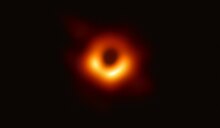Katie Bouman

Katherine Louise "Katie" Bouman (born May 8, 1989 ) is an American computer scientist who works on calculation methods for electronic image processing . From 2016 Bouman played a leading role in the instrument-specific adaptation of the algorithm that enabled the first pictorial representation of a black hole with the help of the Event Horizon Telescope . She was part of a team of 200 people who implemented the project.
She became famous when she was portrayed by various media as the face of community scientific achievement and the importance of women in science in the wake of the publication of the first measured data-based image of a black hole .
Youth and education
Bouman grew up in West Lafayette, Indiana . As a high school student, she did research on electronic imaging with professors at Purdue University . In her senior year of high school in 2007, she first heard about the Event Horizon Telescope , which she would later work on. In 2007 she graduated from West Lafayette Junior Senior High School .
Katie Bouman studied electrical engineering at the University of Michigan and completed her Bachelor of Engineering with summa cum laude in 2011 . She received her Masters in Electrical Engineering from the Massachusetts Institute of Technology (MIT). Bouman was a member of the MIT Haystack Observatory . She was supported by a National Science Foundation Graduate Fellowship. Her master's thesis “ Estimating Material Properties of Fabric through the observation of Motion ” was awarded the Ernst Guillemin Award for best Masters Thesis . Bouman joined the electronic image processing team for the Event Horizon Telescope as a postdoc fellow at Harvard University . In 2016 Bouman held the TEDx Talk “ How to Take a Picture of a Black Hole ”, in which she explained one of the algorithms used in the project. She received her PhD in electrical engineering and computer science from MIT in 2018.
Research and career
Bouman led the team at MIT that adapted the Continuous High-resolution Image Reconstruction using Patch priors (CHIRP) algorithm to the requirements of the Event Horizon Telescope . This algorithm was used to depict the supermassive black hole at the core of the Messier 87 galaxy . The picture was published in April 2019. The algorithm supported calculations in the investigation of the strong interaction in general relativity . The method is based, among other things, on the theory that black holes cast background shadows on hot gas clouds, which was proposed in 1999 by Heino Falcke , Fulvio Melia and Eric Agol . The machine learning algorithm filled in gaps in the data produced by telescopes around the world. Bouman sought progress in the area of image review and image parameter selection for the Event Horizon Telescope.
Katie Bouman joined the California Institute of Technology as an Assistant Professor in 2019 . She is working on new systems for computational imaging processes.
Web links
- Katie Bouman aka Katherine L. Bouman. In: people.csail.mit.edu.
Individual evidence
- ↑ a b Erin Laviola: Katie Bouman: 5 Fast Facts You Need to Know. In: heavy.com. April 10, 2019, accessed April 11, 2019 .
- ↑ Akiyama, Kazunori, et al. " First M87 Event Horizon Telescope Results. IV. Imaging the Central Supermassive Black Hole. " The Astrophysical Journal Letters 875.1 (2019): L4.
- ^ A b Larry Hardesty: A method to image black holes. In: news.mit.edu. June 6, 2016, accessed April 11, 2019 .
- ↑ Sarah Mervosh: How Katie Bouman Accidentally Became the Face of the Black Hole Project New York Times, April 11, 2019
- ↑ a b Dave Bangert: That first black hole picture? A West Lafayette grad played a big part. In: eu.jconline.com. April 10, 2019, accessed April 11, 2019 .
- ↑ Zennie Abraham: About Katie Bouman Creator Of First Black Hole Image From Event Horizon Telescope. In: oaklandnewsnow.com. April 11, 2019, accessed April 11, 2019 .
- ↑ a b Katie Bouman aka Katherine L. Bouman. In: people.csail.mit.edu. Accessed April 11, 2019 .
- ^ A b Jennifer Chu: Working together as a "virtual telescope," observatories around the world produce first direct images of a black hole. In: news.mit.edu. April 10, 2019, accessed April 11, 2019 .
- ^ EECS Celebrates - Fall 2014 Awards. In: eecs.mit.edu. November 18, 2014, accessed April 11, 2019 .
- ↑ Katie Bouman. In: bhi.fas.harvard.edu. Archived from the original on April 10, 2019 ; accessed on September 15, 2019 .
- ^ Professor Katie Bouman - California Institute of Technology. In: scien.stanford.edu. Retrieved September 15, 2019 .
- ↑ Project bids to make blackhole movies - BBC News. In: bbc.com. February 16, 2017, accessed April 11, 2019 .
- ↑ Katie Bouman. In: ted.com. Accessed April 11, 2019 .
- ↑ a b Bill Chappell: First Image Of A Black Hole Is Released By Massive Telescope Project: NPR. In: npr.org. April 10, 2019, accessed April 11, 2019 .
- ↑ a b Michelle Lou, Saeed Ahmed: Katie Bouman: How a grad student at MIT made the first black hole image possible - CNN. In: edition.cnn.com. April 11, 2019, accessed April 11, 2019 .
- ^ A b Caltech Computing + Mathematical Sciences. In: cms.caltech.edu. Accessed April 11, 2019 .
- ↑ Tom Whipple: First image of black hole revealed. In: thetimes.co.uk. April 11, 2019, accessed April 11, 2019 .
- ↑ [astro-ph / 9912263] Viewing the Shadow of the Black Hole at the Galactic Center. In: arxiv.org. Accessed April 11, 2019 .
- ↑ Nadia Drake: First-ever picture of a black hole unveiled. In: nationalgeographic.com. April 10, 2019, accessed April 11, 2019 .
- ^ Imaging the Invisible. In: ee.columbia.edu. Accessed April 11, 2019 .
| personal data | |
|---|---|
| SURNAME | Bouman, Katie |
| ALTERNATIVE NAMES | Bouman, Katherine Louise |
| BRIEF DESCRIPTION | American computer scientist and assistant professor at the California Institute of Technology |
| DATE OF BIRTH | May 8, 1989 |